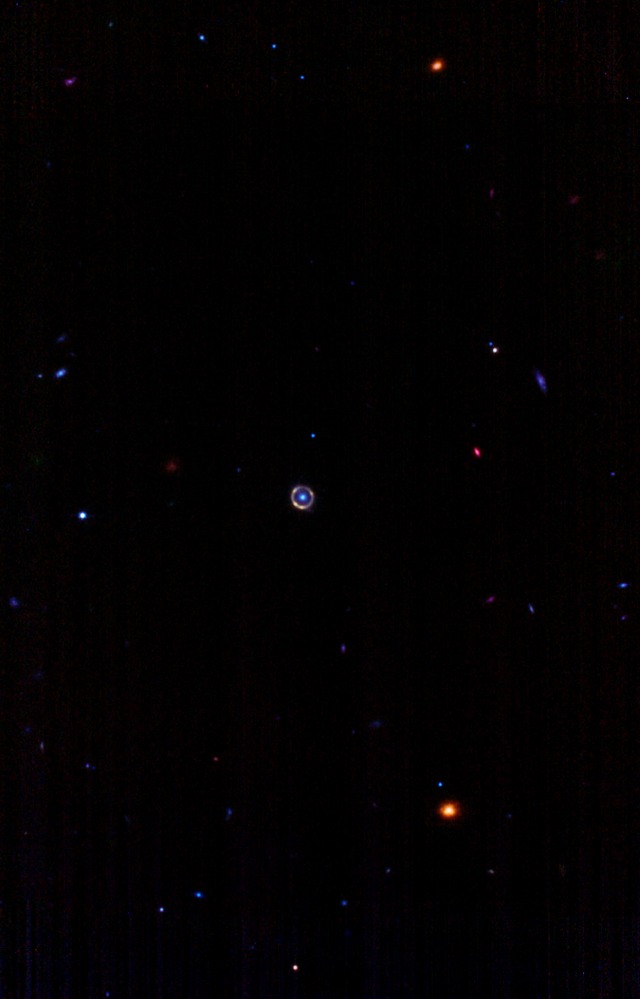The JWST is in a “did you know” on the main page of Wikipedia; likely will stay there for half a day or so.
It appears to be a link to this page.
JWST images translated into sounds:
https://www.nasa.gov/feature/goddard/2022/nasa-webb-s-first-full-color-images-data-are-set-to-sound
Brian
For the first time, astronomers have used NASA’s James Webb Space Telescope to take a direct image of a planet outside our solar system. The exoplanet is a gas giant, meaning it has no rocky surface and could not be habitable.
The image, as seen through four different light filters, shows how Webb’s powerful infrared gaze can easily capture worlds beyond our solar system, pointing the way to future observations that will reveal more information than ever before about exoplanets.
This image shows the exoplanet HIP 65426 b in different bands of infrared light, as seen from the James Webb Space Telescope: purple shows the NIRCam instrument’s view at 3.00 micrometers, blue shows the NIRCam instrument’s view at 4.44 micrometers, yellow shows the MIRI instrument’s view at 11.4 micrometers, and red shows the MIRI instrument’s view at 15.5 micrometers. These images look different because of the ways the different Webb instruments capture light. A set of masks within each instrument, called a coronagraph, blocks out the host star’s light so that the planet can be seen. The small white star in each image marks the location of the host star HIP 65426, which has been subtracted using the coronagraphs and image processing. The bar shapes in the NIRCam images are artifacts of the telescope’s optics, not objects in the scene. (Unlabeled version.) Credit: NASA/ESA/CSA, A Carter (UCSC), the ERS 1386 team, and A. Pagan (STScI).
NASA’s James Webb Space Telescope has snapped a perfect shot of an “Einstein ring.” The stunning halo is the result of light from a distant galaxy passing through warped space-time surrounding another galaxy aligned between the distant light source and Earth. The new image, which was created by a Reddit-based astronomy enthusiast, is one of the best examples of the trippy astronomical phenomenon ever captured.
Here’s a slightly better image of the Einstein Ring than Live Science’s version:

Annoyingly I can’t find a super rez version on Nasa’s pages.
Not sure these 2 facts are related. Plus, even our own galaxy is at least that old.
Yes - why is that ?
(Maybe because the NASA only does numbers, and the pics are created by
outside agencies ?)
Well, not inhabitable by humanoids, but it could possibly be habitable for very different creatures.
New pics of the Tarantula Nebula:
https://www.nasa.gov/feature/goddard/2022/a-cosmic-tarantula-caught-by-nasa-s-webb
Brian
That image is my new desktop. Thanks for posting it.
Also pretty: the Phantom Galaxy
I suspect all of these gorgeous images that NASA is passing off as galaxies are just cotton strands stuck on the telescope mirror. ![]()
Just be glad there’s no ants up there or we’d all be having a Kent Brockman moment.
Yes, those two facts ARE related.
Current estimates of the age of the universe is around 14 billions years and change. For part of that time just after the Big Bang it is believed that galaxies couldn’t exist because of physics reasons I’m not qualified to explain and don’t really understand.
If the galaxy is 12 billions light years away from us then the light from that galaxy has been traveling towards us for all of that time, meaning this galaxy must have existed in the form we see it 12 billion years ago, making it very old indeed, and certainly younger than more recently formed galaxies.
This is not incompatible with our own galaxy also being very old indeed. There’s no reason we can’t be living in a galaxy that is also one of the oldest.
Hmm, but if the galaxy is currently 12 billion LY from Earth, then couldn’t the galaxy be much younger (when accounting for the expansion since then)? IOW, just because a galaxy is currently 12 billion LY, does it mean that the galaxy is actually that old?
That would be the light coming from the galaxy being 12 billion years old. It does not show where the galaxy is in relation to us right now. Presumably, in the intervening time period, and thanks to the expansion of the universe, it is even further away than 12 billions light years.
But I’m not an astrophysicist. I could be wrong on this.
That would be the light coming from the galaxy being 12 billion years old. It does not show where the galaxy is in relation to us right now. Presumably, in the intervening time period, and thanks to the expansion of the universe, it is even further away than 12 billions light years.
When they say a galaxy is 12 billion years old, what they really mean is that the light from that galaxy has been travelling towards us for 12 billion years. At the time the light was emitted, the galaxy was much closer than 12 billion ly and currently it’s much further away.
and currently it’s much further away.
…assuming it still exists !
Nothing lasts…but nothing is lost
